-
Posts
868 -
Joined
-
Last visited
-
Days Won
2
Content Type
Profiles
Forums
Events
Store
Downloads
Gallery
Posts posted by Lee Bray
-
-
Etched or stamped, difficult to say for certain with the pic but I'm curious as to why you think it is Chinese?
Kissaki is properly shaped and defined and the kuri-jiri is properly shaped. It also appears to be machi-okuri, which I've never seen with fakes.
FB has also dropped it in the fake box based on the arabic numerals and stamped characters, but a look through the arsenal stamps topic in militaria shows all are possible. Ignoring the unusual nakago markings, the sword itself, shapewise, is legit.
Since it was found in '66, that would make it one of the very first fakes to be made, if they had even started back then, so it seems the fakers are going backwards with their sugata.-
 3
3
-
-
8 hours ago, Brian said:
I don't think it's signed, I think it's stamped. And I have the feeling we have seen this before. Hmmm
Meaning this sword or the stamped mei? I'm confused...
-
A friend in Hong Kong owns this unusual Showa-to. It was found in the basement of the Salisbury building by the owner in 1966. I mention that just because the building is around the corner from the Peninsula hotel, which was the Japanese military HQ during their occupation of HK in WW2.
It has an unusual mei, possibly stamped Soshu script? It also has three, seemingly defaced arsenal stamps and the numbers 258.
I have no clue as to what it says so looking for translation help, please. -
The seam is central on the ura because of the emperor node placement being central on the omote. As that node is central on the skin, I assume it's easier to measure and a more economical way of using the skin. It also means there is a solid piece of same over the seam in the wooden core which would make for a more solid handle.
I've also read(where, I can't recall) that the seam is put on the side so the user/owner can tell it is a full wrap of same, though obviously a panel can be cut in two and the seam faked.
I've got an old tsuka(wakizashi) that has 3 pieces of same, omote is one piece with nice emperor nodes and ura is two pieces, joined in the centre but also joined mune and ha, negating the added strength of the full wrap but simulating it.
But I suppose it's purely speculative to assume a full wrap makes a tsuka stronger; likely it does but is it over engineered? I don't know. -
-
Technique is called Uchidashi. As Geraint says, the piece is originally punched from the back to give height to the elements on the front, then the front is worked to give detail. No moulds are used.
Here's a video of the technique by the man himself, Ford Hallam.
-
 6
6
-
-
Seems Hans Koga has used this apparent book as a scam.
Paul Martin's page -
A translated post from Izumi Koushiro -
From now on, we would like to particularly warn international sword enthusiasts to please be careful of the Swedish person who goes by the name of Hansuke (Hans) Koga (Real Name Hans Igelstrom) who currently works as a Tsukamaki (handle wrapper) in Kumamoto Prefecture, Japan. He appears to have studied a little, but is not a fully fledged craftsman. However, because he can speak English, he seems to get some requests for work (from overseas).
When he appeared on (Japanese) TV last year, he claimed that he was the only person who could do Higo Koshirae (mountings). As you would expect, the local craftsmen complained to the TV station, and the program was stopped from being rebroadcast.
First of all, Mr. Koga was looking after about ten swords of an acquaintance of mine, but he sold two of the best ones out of them without permission and has not returned the money. That is a crime. Since last year, the victims (my acquaintance) appointed me as an agent to pursue Mr. Koga. I consulted with a lawyer, but even if we filed a lawsuit in a civil trial and Mr. Koga did not have the ability to pay the money, it just costs more money such as lawyer fees. As there has been no attempts by Mr. Koga to pay money back, my acquaintance is trying to make his case.
Furthermore, Koga Hansuke recently wrote and published a book. He has received payments from customers but has not sent the books. This is a complete scam.
Mr. Koga was renting a workplace in a private village run by Tamana City in Kumamoto, but he stopped renting there at the end of March (2020). It turns out that he was only renting the space at the Folk Village, the problem was that they allowed it without properly vetting Mr. Koga. I realize that the person in charge understands that non-Japanese who live in places like the private folk villages will also become a kind of advertisement/attraction. However, I would like to ask those who lend without checking carefully to reflect a little on their actions .
In any case, we will pursue Koga Hansuke to stop using Japanese traditional crafts as a cover. This is a notice for Japanese and International swords enthusiasts to be careful.
Koushiro Izumi
Trustee: Nihonto Bunka Shinko Kyokai (NBSK)-
 5
5
-
-
First one suggests Hirata Hikozo in style but work suggests school work or later utsushi.
Second, I agree with Peter that it looks like Umetada Myoju but again, while this work appears well done, it's not as bold or well executed as Myoju, so would have to plumb for school work or later ustsushi.
Both very nice though and I'm also a fan of copper or brass tsuba.
-
With Daruma being there, it's likely they are omamori which are small amulets dedicated to Buddhism and Shinto kami.
-
From the exhaustive "Nihonto swords of Japan: A visual Glossary", it is called a Tsukikama yari.
Edit - a quick google brought this up - http://gunbai-militaryhistory.blogspot.com/2018/01/hoko-early-Japanese-spears.html
-
I prefer the overall look of the radish/daikon tsuka. I like the earthy tones, the more elegantly shaped tsuka and the tsukamaki is well done and blends/flows in to the fuchi and kashira much better than the horse tsuka.
The horse fittings look good and the nanako is reasonably well done but the tsuka looks stumpy, there are no curves to it, the ito looks so so and does not flow while the kashira knot looks enormous.
-
 1
1
-
-
Yes, hira-zukuri katana. I owned one once, a rather slim example, and it did not feel very substantial. Rather like it would bend if you swung it too hard.
I understand(I'm not a sword swinger) that they make very good soft target cutters but can very easily take a bend if not handled well. There's a modern made katana in hira-zukuri, I forget the maker, that does very well in tamashigiri competitions. Apparently it's made rather thick and wide to try and prevent bends, but it still does.
-
That's a reef knot, or sometimes called a square knot, if that helps any budding tsukamakishi.
-
The post looks like it's been moved to the 'For Sale or Trade' section.
http://www.militaria.co.za/nmb/topic/31303-two-tanegashimas/
-
 1
1
-
-
Happy to be corrected as you're right, Uwe.
One letter is one letter otherwise you'd be pretty instead of petty...

-
 4
4
-
-
Hi Chris.
You say an aikuchi tanto..."aikuchi" relates to the koshirae and means 'without tsuba'(not sure on the exact translation) and your koshirae has a tsuba. Because it's a small tsuba, it is refered to as a "hamadashi" koshirae. So, technically, you have a tanto in hamadashi koshirae.-
 1
1
-
-
Probably a modern made addition done so the tsuba could be mounted without installing 'proper' sekigane or hammering the steel around the ana to fit a nakago.
Adding sekigane can potentially damage the patina on the tsuba as you have to hammer it in to position which is a lot easier to write/say than do.
I sold the tsuba below a long time ago and the new owner wanted to mount it so I made the 'odd' sekigane to facilitate that. I made the ana undersized so the new owner just had to file the sekigane a little for a perfect fit.
-
 3
3
-
-
I'd also say cast reproduction of Echizen Kinai so likely the answer will be entirely different.
-
 1
1
-
-
There should be no problems with import and no taxes to pay.
-
Hama-mono would be my take on this tsuba.
-
 2
2
-
-
Maybe an ill squirrel?
-
Apologies for trying to help and be humorous, Stephen.
-
They look like you could pull on the end and the whole thing would unravel instantly.
It's called 'daisy chaining' in rigging terms.
But I guess you need to be a rigger to see that and not have to rely on fancy pant PDF's to tie a knot.
(apologies to non riggers and Guido)

-
Looks like it's just half of the 'standard' sageo knot.
When you have the sageo equally pulled through the kurikata, instead of tying either side of the kurikata with an individual end of the sageo, you need to double up the sageo and tie the knot as normal in the direction of the kojiri.
I've attached a pic which will hopefully get the point across.
In case you were wondering, that's not a real saya and sageo, I just have some crazy 'paint' skills.


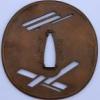
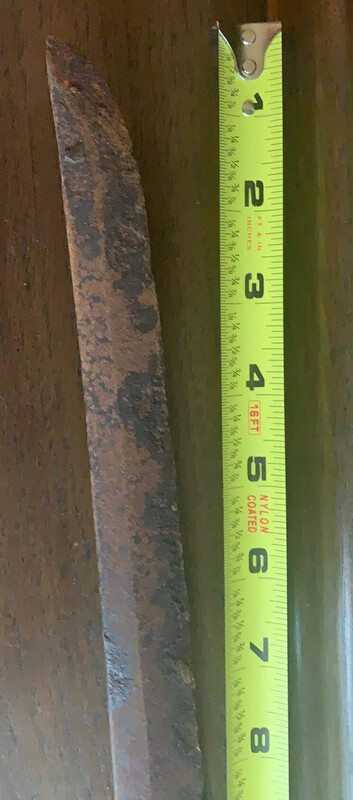


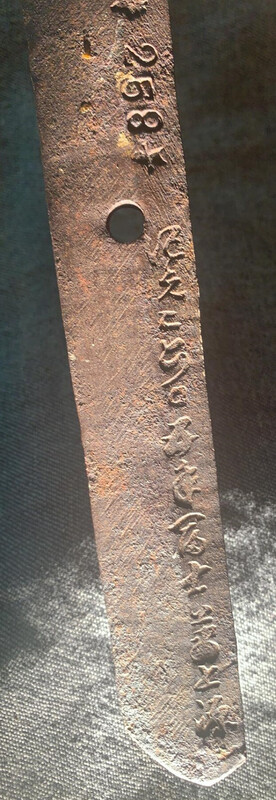
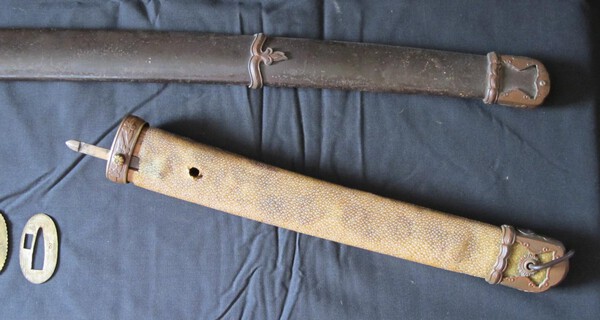
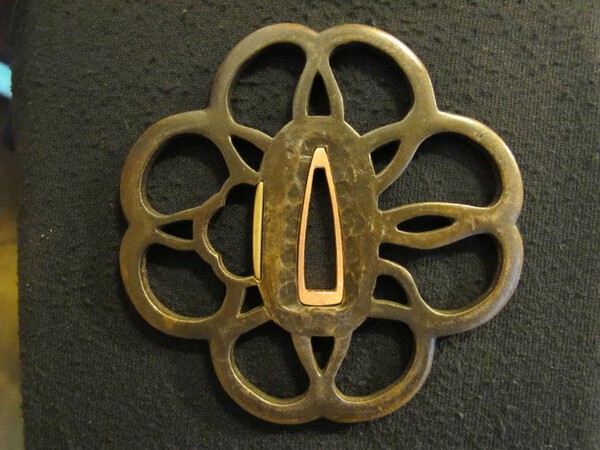
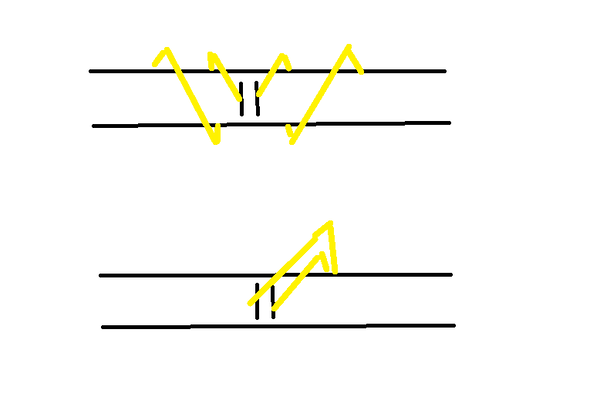
Soshu script? Showa-to mei.
in Translation Assistance
Posted
Many thanks to Moriyama-san, Steve, et al.
I've passed on the info to the owner. I've also asked him if he wishes to pay for a Sesko translation but for that I assume I'll have to visit him and get some decent shots of the nakago, which I'll post here if it happens.
Thanks again.